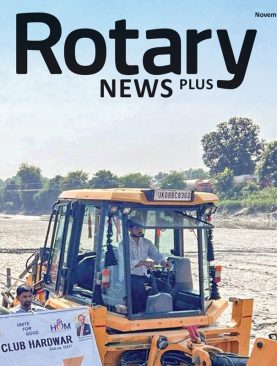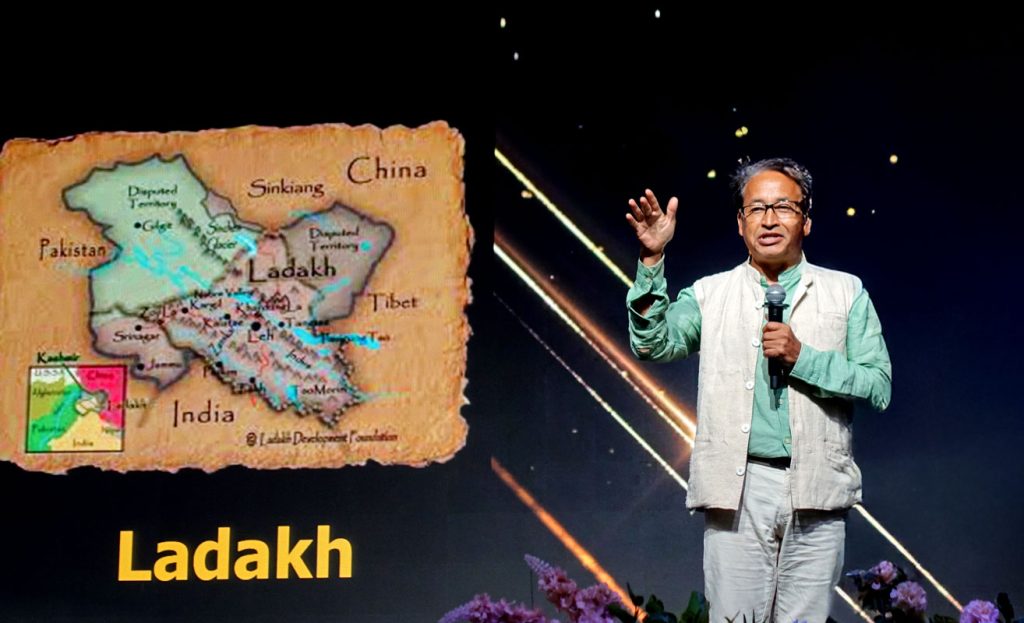In a world where violence and conflicts are tearing apart nations and wars are being waged in different parts of the world, environmentalist Sonam Wangchuk left the participants of the Kochi Institute with a different thought when he said: “when we talk about world peace, today’s problem is not the huge war going on between nations but between man and nature. I believe that the World War III is already on between human beings and nature.”
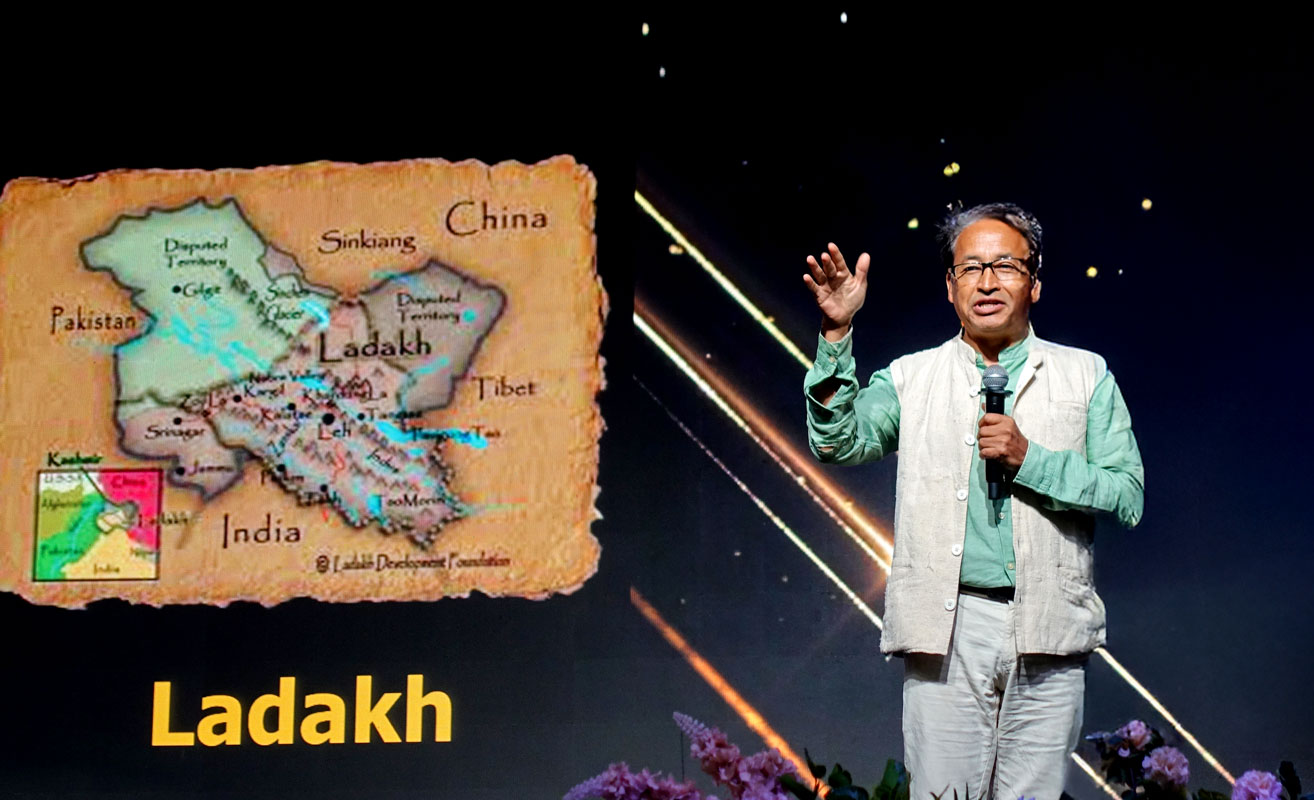
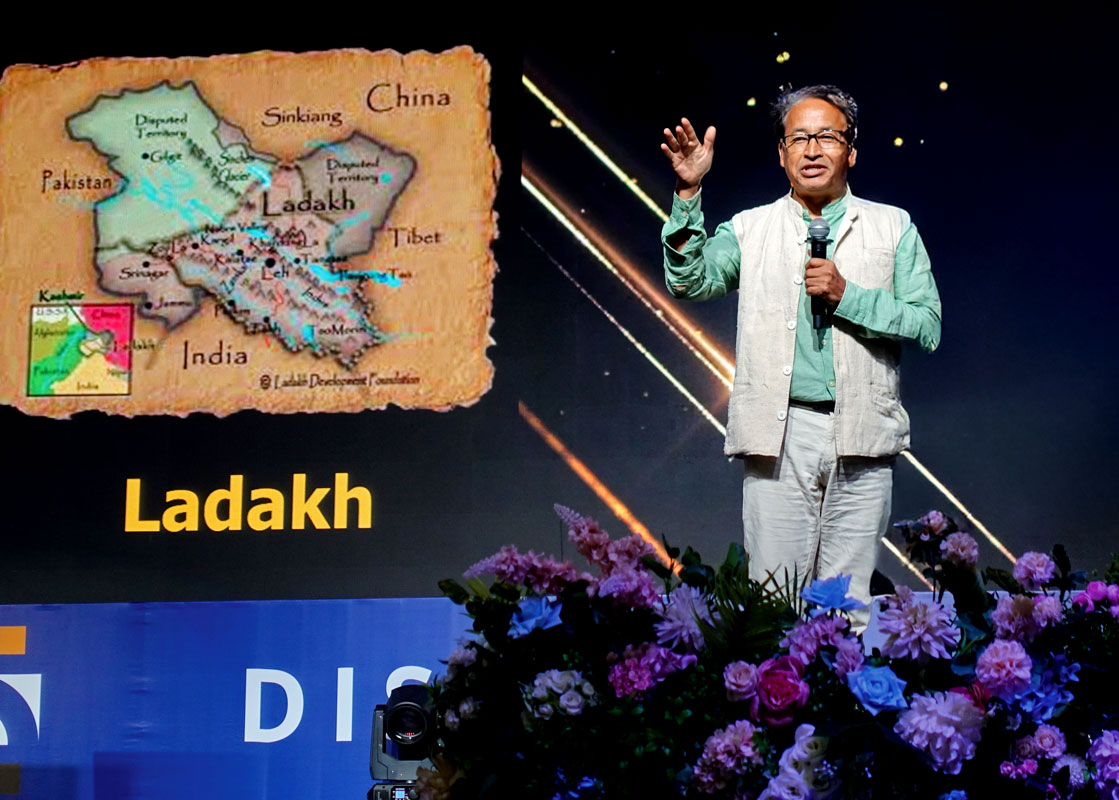
He proved his point with statistics. Every year, seven million people die of air pollution alone. If you add other climate-related deaths, it’s 10 million people. “I was thinking what does this figure of 10 million people mean… what is this number? I naturally thought of the two big wars, World Wars I and II, which together lasted roughly 10 years. Around seven million people died from them, but from reasons related to environmental degradation and pollution we lose 10 million every year. This means World War III is already on.”
But the answer to this huge problem will not come from “solar-heated buildings or electric vehicles or technology in any form. The answer has to come from the whole discourse changing, and when religious leaders, who people listen to…. nobody listens to scientists… will take up this subject in their discourse and makes it a priority.”
But even better than that, he said, was that “we become once again nature worshippers, as we were before any religion came.” He hastily added that for this we didn’t have to give up our current religions, but just tweak them a little and “become an adapted, updated version of Hindu, Muslim, Christian or Buddhist nature worshippers, and that will show us the light.”
Calling for adapting to a lifestyle that takes care not only of “our future but also that of the rest of beings who share this planet with us,” Wangchuk said the answer to the problems of today’s world lay not “in the blind rush for growth and development of the kind we have seen in the last 300 years; more of that will only get us further down.”
He would seek the answer from the Indian traditional wisdom and what the Buddha had said 2,500 years ago, that “a human being’s success lay not in fulfilling one thousand desires, such as the best of cars, houses, clothing and material wealth, but the elimination of a single desire, rather than its fulfillment. That is the kind of innovation we need on this planet, not technological or of the engineering kind.”
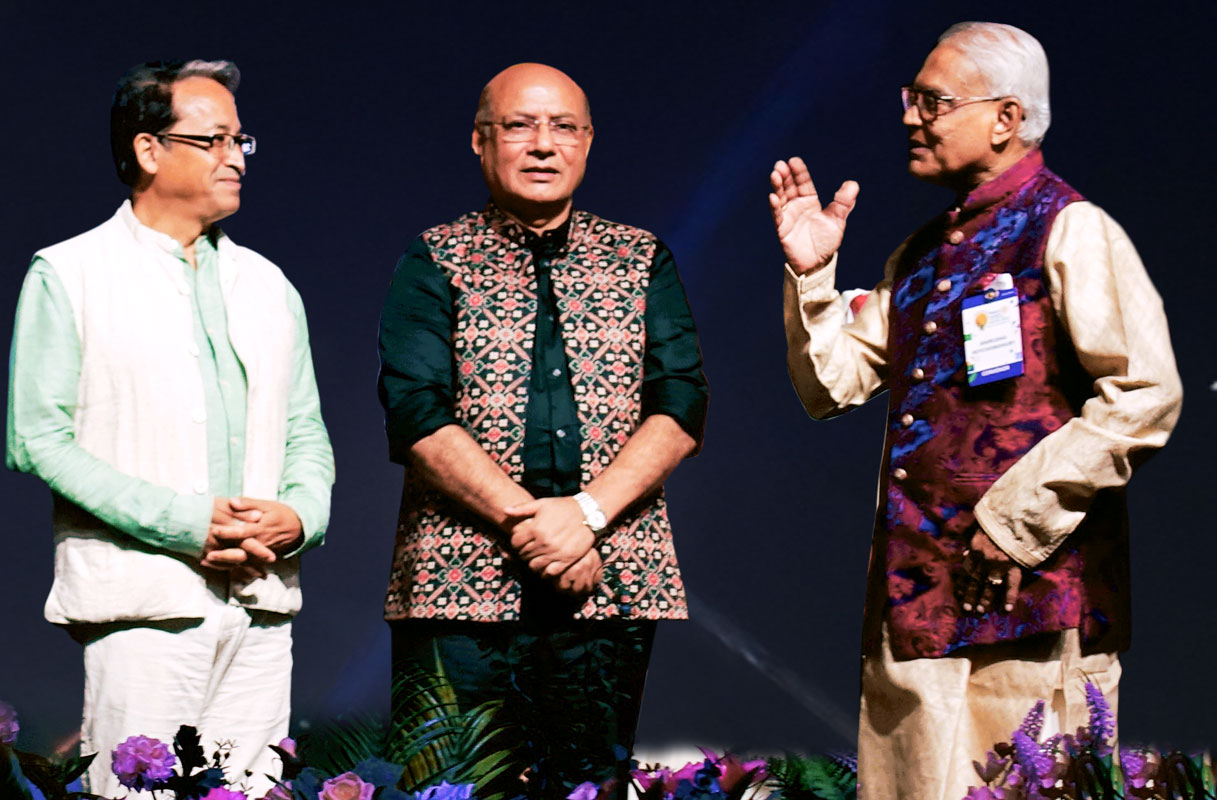
The founding-director of the Students’ Educational and Cultural Movement of Ladakh (SECMOL), on whose life experience Aamir Khan’s role as the scientist Phunsukh Wangdu in the Bollywood blockbuster The 3 Idiots was based, mesmerised the Kochi Institute audience with his profound talk that was wrapped up in stark simplicity and plain speaking.
To begin with, the environmentalist who lives in the fragile ecoregion of Ladakh, took a potshot at the super cool auditorium where the Institute sessions were held, and where men were wearing jackets. “I had hoped to bask in the warmth of Kochi with a single shirt. Little did I know that I would dress almost as I do in Ladakh, and I do see many of you in three-piece suits.” Spelling out the damage done by excessive air conditioning, he said that a temperature of 27 deg C is comfortable in India; every degree lower required six per cent energy. To maintain a room temperature of 20 deg C meant expending 40–50 per cent more energy.
In Ladakh, of course, the temperature these days was – (minus) 20 deg C and “soon it will go to -25 deg C,” he said, thanking the organisers for making him “feel at home in Kochi, dressed in a jacket!”
Wangchuk then proceeded to peel off layer after layer of the climate crisis that is facing our world, particularly the fragile Himalayan zone “that I come from and where we are seeing the brunt of what is called climate change in real time. No place could be more different; Ladakh is more like another planet, and it is not in, but across, the Himalayas or trans-Himalayas, and where nature has left us high and dry.”
Himalayas, he said, “are lush and green like Kashmir, Shimla. But across Himalayas is a very different world. When I open my windows in the morning, it looks more like Mars than Earth. Like outer space, temperatures here go from +35 deg C in summers to -35 in winters. This is one place, they say, where you can have sunburn and frostbite at the same time, if your head is in the sun, and feet are in the shade.”
Despite this region facing climate change in the most severe ways, human interventions could, and had made magic happen. Showing pictures of green patches in a Ladakhi village, he said this was “the doing of not nature but our ancestors in a region which is not blessed by monsoon as yours is.”
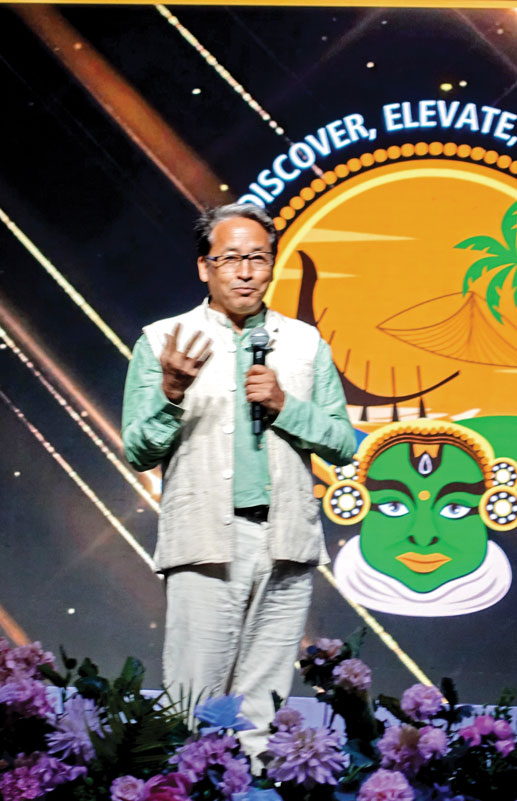
Such green patches were possible thanks to innovative adaptations by local farmers who had channellised melting glaciers, bringing a trickle of water to the dry patches of sandy land by carving the rocks. “Thanks to the magic they created thus, we have barley, wheat, fruits like apricots, apples, peaches, plums, growing here. And not only have the people survived over the ages, but also their colourful civilisation has thrived with its own music, dance, literature and spirituality.”
But now, thanks to global warming and climate change, the region was facing a huge challenge. “Our glaciers are melting away very fast. You may watch on television, but you don’t know what it does to people in the high Himalayas, and very soon it will have its impact on the rest of the country and planet… North India specifically.”
Wangchuk said this region hosted most of the world’s glaciers and frozen freshwater. “After the North and the South Pole, this region is called the Third Pole, the Hindukush Himalayas.” Displaying a picture he had clicked from the airplane that showed 10 glaciers, he said the region had around 50,000 glaciers which were so precious for our planet. “And as they melt, you get the rivers of North India flowing down to the plains and nourishing life. This part of the planet directly or indirectly supports around two billion people, or a fourth of the world’s population.”
But these glaciers are melting at an alarming rate. Showing the picture of a tall glacier “which used to be towering high that I used to admire as a teenager, is today a shadow of itself. Every summer it flows down, roaring on its way down as the planet warms up and summers get hotter.”
The implications of this melting are grave. Giving an example, the environmentalist said that in 2006, there was a big flash flood in a village next to their school, which was devastating. It wiped out many farms, fields, animals and homes. Along with his students he went there to volunteer relief efforts. He asked a villager in his 80s how frequent such calamities were, and he said he hadn’t seen anything like that in his life. “That was 2006; the next disaster came in 2010, when a quarter of Leh city was wiped away and 1,000 people were lost, followed by two more big ones in 2013 and 2017, with several small ones in between.”
This grave situation in the high Himalayas is not only devastating lives of the local people, “it’s also taking away the water that your children should have had in the next generation, causing floods now but impending drought for the next generation. Because these are the glaciers that have fed North Indian, Gangetic and the Indus plains in Pakistan. The water’s coming down in a fury that is devastating; but what comes tomorrow will be even more devastating.”
Creating artificial glaciers
Urging Rotarians to “understand the gravity of the climate crisis and the urgent need to change and adapt innovatively to the present crisis,” Wangchuk said to tackle the impending shortage of water from melting glaciers, “we’ve started working on artificial glaciers thinking that even though the natural ones are melting away, till there is some flow, let’s recreate glaciers ourselves.”
This involved refreezing the stream water, “which still flows in winter. You’d think it freezes, but under the ice some water still flows. We freeze the glaciers using geometry shapes, which the children learn at school. Normal ice happens horizontally… flat, and that is exposed to the sun and melts in early spring. But when you use a little geometry, and create spherical and conical shapes, you get low surface area and high volume. And farmers need just that.”
He added that they had built glaciers that had a height of 6 to 12 storeyed buildings, with the big ones having the capacity to hold 10 million litres of water. “They form in winter and then, because of the shape, don’t melt in March or April, unlike ice on the ground. They stay till June when farmers really need the water and there is no sign of ice anywhere.” As this artificially created glacier melts slowly, water becomes available as the system works like a drip irrigation. So, you have trees blooming in deserts that have never seen trees, he said.
But, Wangchuk admitted, these were very small measures and he wasn’t really proud of them. “These little artificial glaciers or solar power will not change the destiny of the Himalayas and its glaciers. Innovation needs to happen at much larger scale for things to change on this planet.”
Unfortunately, we are not adapting what is required fast enough. “We think that engineers and technologists will find solutions. The problem is not technology, it is our outlook towards the world, our sensitivity for the future generations, our empathy for fellow beings, not just humans. All the other beings on this planet… plants, animals, birds, insects… have equal rights on the planet. We humans actually deserve to be punished for what we are doing.”
Putting faith in the human being’s traditional quest for innovation, Wangchuk said, “I think human beings’ biggest innovation is not one of rockets or electric vehicles. To me, their biggest innovation is the concept of God. That needs to be re-adapted to current times.”
Because it dated back to the times when there was no law or system, might was considered right, “and if we had differences, I could break your skull open if I was stronger. And nobody would question me.”
So in a world filled with violence, where might was right, man came up with the concept of something that was way stronger — God and religion — and voila, it worked! But now to deal with today’s problems, a new version, God 2.0 is needed, “with the concept being adapted to current times to enable us to address today’s problems,” he concluded.
Wangchuk’s magical school

In order to combat the challenges posed by the climate crisis created by environment degradation in the high Himalayan region, “we are trying our bit in Ladakh to adapt and innovate to mitigate the impending disaster. For the last 35 years at our school, we are trying to innovate ways to adapt locally. But today we need to adapt and innovate globally. Our little interventions alone will not help,” said noted environmentalist Sonam Wangchuk, addressing the Kochi Institute.
Started in the 1990s to bring reforms in the education system, “where failure was a big thing, it tries to prepare young people for a future that is very different from the past.”
This (SECMOL) school was built with natural materials like mud or earth, found right under our feet. And it is powered by the sun. In an extremely cold place like Ladakh, no energy, fossil or otherwise, is used to warm this school in winters or even to cook. Everything happens with solar energy in this school, which he said is perhaps the first carbon-neutral school in the world.
But that is not the most important issue, said Wangchuk. The students learn by living and experiencing things and solving hands-on real-world problems through the education they receive. “Rather, I’d say, they make the world a classroom and apply what is in the books to solve these problems… with solar cooking, solar power, organic gardening and so on in a campus that is fully solar powered. Almost everything happens with sun, which we have in plenty, be it cooking or green houses producing fresh vegetables, lighting, electricity, water heating, water pumping… even cows on our campus live in solar-heated cowshed.”
The school was about innovations in building in the harshest remote, forsaken place; such buildings can be made in any place needing sustainability. “These buildings have an indoor temperature of +18 deg C when it is -20 deg C outdoors, without a drop of oil, air, wood, coal or any other fuel. And the beauty is that with a little definition of physics for the solution and geography for the orientation, the buildings are coolest in summer and warmest in winter.”
Wangchuk added this technology is now being extended to the rest of Ladakh, a heavily militarised place. “This means that 100,000 soldiers would be burning oil and fossil fuels to keep warm, as many come from warm places like South India. This causes carbon emission to a degree that you can’t even imagine. A million tonnes of emission in that very fragile region from armies of three nations — India, China, and Pakistan. So we are now extending this technology to the Indian Army, which I believe is the most ecologically progressive among all three.”
He added, “Our Army now lives in fully solar-heated, carbon-neutral shelters which are done by us in collaboration with them. This saves them using fossil fuel, carbon emission and fire accidents. More soldiers in that region die of accidental fire than enemy fire. So now our soldiers live warm and happy in those heights.”
He added that in “their or our homes, and school, temperatures always remain between 18 and 25 deg C dec in the coldest winter. At any time, it is warmer than in a house in Delhi. And every time I come down to Delhi from Ladakh, I feel cold. This is how you can be, if you use a little bit of science and innovation.”




